Overview:
Mt. Baruntse, a prominent mountain in the Himalayas, nestled in the Khumbu region of Nepal. A
part of the Mahalangur subrange, which includes several of the world’s highest peaks, such as
Mount Everest, Lhotse, and Makalu. Mt. Baruntse stands at an elevation of approximately 7,129
meters/ 23,389 feet above sea level, making it a challenging peak to climb and a popular
destination for mountaineers seeking to test their skills at high altitude.
Overall Itinerary:
12 th October/ Day 1: Arrival in Kathmandu (1,400 Meters/4,593 Feet)
13 th October/ Day 2: Kathmandu sightseeing and trek preparation. (1,400 Meters/4,593 Feet).
14 th October/ Day 3: Fly to Lukla (2,800 Meters/ 9,186 Feet )
15 th October/ Day 4: Lukla (2,800 Meters/ 9,186 Feet ) to Chutanga (3,050 Meters/10,006 Feet).
Trekking Time: 4 Hours.
16 th October/ Day 5: Chutanga (3,050 Meters/10,006 Feet) to Thuli Kharka (3,900 Meters/12,597
Feet). Trekking Time: 7 Hours.
17 th October/ Day 6: Tuli Kharka (3,900 Meters/12,597 Feet) to Kothe (4,095 Meters/13,435
Feet). Trekking Time: 5 Hours.
18 th October/ Day 7: Kothe (4,095 Meters/13,435 Feet) to Thangnak (4,350 Meters/14,272 Feet).
Trekking Time: 4 Hours.
19 th October/ Day 8: Acclimatization Day at Thangnak (4,350 Meters/14,272 Feet).
20 th October/ Day 9: Thangnak (4,350 Meters/14,272 Feet) to Khare (5,045 Meters/16,551 Feet).
Trekking Time: 3 Hours.
21 st October/ Day 10: Khare (5,045 Meters/16,551 Feet) to Mera La Pass (5,350 Meters/17,542
Feet). Trekking Time: 5 Hours.
22 nd October/ Day 11: Mera La Pass (5,350 Meters/17,542 Feet) to Seto Pokhari Camp (4,850
Meters/15,912 Feet). Trekking Time: 5 Hours.
23 rd October/ Day 12: Seto Pokhari Camp (4,850 Meters/15,912 Feet) to Baruntse Base Camp
(5,300 Meters/17,400 Feet)
24 th October -7 th November/ Day 13-27: Climbing period (7,129 Meters/23,389 Feet)
8 th November/ Day 28: Baruntse Base Camp (5,300 Meters/17,400 Feet) to Seto Pokhari (4,850
Meters/15,912 Feet) Trekking Time: 6 Hours.
9 th November/ Day 29: Seto Pokhari (4,850 Meters/15,912 Feet) to Mera La (5,350
Meters/17,542 Feet). Trekking Time: 6 Hours.
10 th November/ Day 30: Mera La (5,350 Meters/17,542 Feet) to Kothe (3,600 Meters/11,811
Feet). Trekking Time: 5 Hours.
11 th November/ Day 31: Kothe (3,600 Meters/11,811 Feet) to Thuli Kharka (3,900 Meters
/12,597 Feet). Trekking Time: 5 Hours.
12 th November/ Day 32: Thuli Kharka (3,900 Meters /12,597 Feet) to Lukla (2,800 Meters /9,186
Feet) Via Zatrwa La Pass(4,610 Meters/15,125 Feet). Trekking Time: 9 Hours.
13 th November/ Day 33: Lukla (2,800 Meters /9,186 Feet) to Kathmandu (1,400 Meters/4,593
Feet). Flight Duration: 35 Minutes
14 th November/ Day 34: Leisure day in Kathmandu (1,400 Meters/4,593 Feet).
15 th November/ Day 35: Final Departure
If you have any inquiries or require assistance and further information about this trip or any other
trips, please feel free to contact the Alpine Club of Himalaya – Walk of the Himalaya.
NOTE: All of the aforementioned trekking hours are approximations and should only be used as a general guideline.
Entry Permits and Requirements:
The Baruntse Himal Expedition requires the following permits:
Sagarmatha National Park Entry Permit and
Khumbu Rural Municipality Entrance Permit.
The Nepal Tourism Boards’ office in Kathmandu or the park’s entrance gate in Monjo can provide you with Sagarmatha National Park Entry Permit for NRS 3000.
The fee for citizens of SAARC nations is NRS 1500.
You must complete the permission application and present your passport or a copy of your
passport. You must be in Lukla to obtain the Khumbu Pasang Lhamu Rural Municipality
Entrance Permit. The permission costs NRS 2000 and may be acquired at the rural municipality
counter on the outskirts of the settlement.
Baruntse Himal Expedition Climbing Fee:
Spring Permit costs | 500 $ per person.
Autumn Permit costs | 250 $ per person.
Winter/ Summer Permit costs | 125 $ per person.
NOTE: You won’t have to worry about waiting for permits since the Alpine Club of Himalaya
or our guides will take care of everything.
Meals and Drinking Water:
Everest region Trek is one of the most facilitated trekking destinations in the country, providing
basic to luxury ones.
In this trial, you’ll be provided with a variety of cuisine to choose from. Nepali, Tibetan, Indian,
western as well as continental meals. As the region has small tea houses to luxury hotels the
facilities, they provide are basic to grandeur according to your budget. Try various traditional
cuisine and popular snacks and delicacies renowned in the region.
Similarly, drinking water is accessible with natural water supplies which are untreated, so direct
use of the water is not recommended, you may refill boiling water or cold filter water from any
of the teahouses. However, if you buy a water purification tablet, chlorine drops or utilize SODIS
(sunlight assisted) filtration procedures for further assurance, saving money and reducing plastic
pollution.
Accommodation:
Accommodations are available in trekking lodges, and teahouses as well as several hotels all
along the trail, providing basic well-maintained, reasonably luxury 5-star ones with additional
needs according to your budget. Tea houses on the trail vary in quality and price, depending on
the amenities they feature.
The tea house’s rooms have shared beds and some basic furniture like a small table or a chair.
Normally, beds contain pillows and sheets and almost all tea houses provide extra blankets as it
will be freezing at night. Usually, hot showers are available throughout the trek.
For trekkers who want to Camp, various campsites are available along the. From Base Camp,
you will be accommodated in makeshift camps.
Best Time to Visit?
The best season for trekking to Everest region is during the season of autumn and spring, the
months of September, October, November, March, April, and May.
During the autumn season, the months of September, October, and November the weather is
clear with warm temperatures and the visibility is great. As the weather is mild it’s very easy to
get around the region.
The spring season of March, April, and May is also the best time to visit the Everest region,
marking the end of the winter, the spring season brings a change in the topography of the region
and the destination comes to life with endless rows of different colored rhododendron, moss, and
orchid draped trees, colorful undergrowth stretching for miles and the snowy white mountains
peaks on the backdrop of clear blue skies.
Monsoon season is not favorable for trekking as the weather gets harsh and it’s hard to get
around the country with frequent landslides and floods. So usually, monsoon season is avoided
by trekkers.
In the winter season, the area receives a high amount of snowfall, covering most of the trail and
access is denied to most of the regions of Everest, making it impossible to trek.
Travel Insurance:
All clients participating in any activity must have travel insurance. Personal injury, death,
hospital expenditures, repatriation fees, and helicopter rescue. Any other disease covered by the
insurance plan will be given. We highly advise you to acquire a comprehensive insurance plan
from a trustworthy insurance company.
Passport and Visa:
Every client must have a valid passport from the return date with a 6-month prior validity by the
Nepalese consulate in your country or the immigration office at Tribhuvan International Airport
in Kathmandu.
Equipment Lists:
General Equipment Required:
- Find the guidelines regarding essential trekking gear.
- Daypack above 40 liters. (Must be waterproof)
- Down jacket (rental available)
- Warm sleeping bag (rental available)
- Sun head, gulf cap, sunglasses, headlamp, and torchlight.
- Ear-muffs, wooly Hat, Fleece Balaclava
- Sun Lotions/sun cream.
- One pair of liner gloves is thin wool and synthetic.
- Cotton t-shirts, Synthetic t-shirts.
- Thermal Top, Fleece Salopettes, Thin Fleece
- Body Warmer – Thick Fleece -Schoeller Trousers
- Long-sleeve polyester or synthetic lightweight for sunny days.
- One Soft-shell jacket (water & wind resist)
- Inner clothes as your requirement.
- Liner socks, woolen socks.
- Proper trekking shoes, Sandals
- Imodium or Pepto Bismo capsules for upset stomach or diarrhea.
- Diamox for altitude sickness. The guide will help you to take it.
- One small personal-sized first-aid kit with blister treatments such as moleskin, bands,
- anti-infection ointments, and muscle relief ointments
- Wet wipes
- Vitamin Tablets
Technical Equipment Required:
- Ice Axe, Ice Hammer
- Harness, Crampons, Ice Screws
- Belay Plate, Jumar and Ropeman, Prussicks
- Rack – Tat + Maillons – Abalokov Threader
- Head Torch x 2 – Spare Batteries + bulb – Rope
- Helmet – Radio + Batteries – Spare Pick
- Repair Kit (tape, superglue, string, cable ties, strap, needle, thread, leatherman with pliers)
Important Note:
Your safety is of paramount importance to us at the Alpine Club of Himalaya. We have the
absolute authority to cancel the trip or change the itinerary, when deemed necessary or when we
have reason to believe your safety is at stake. Weather conditions, the health condition of a group
member, natural disasters, and such, can contribute to changes in the itinerary when traveling in
remote mountainous regions. In these extreme situations, we kindly request that you offer your
full cooperation to the trusted leader of the group appointed by the Alpine Club of Himalaya.
However, we assure you that we will make every effort to keep to the above itinerary.
ALIPINE CULB OF HIMALAYA
WALK OF THE HIMALAYA
Overview
Mt. Baruntse is situated in the Barun Valley, to the south of Mount Everest and Lhotse, and to the
north of Makalu. It lies within the Sagarmatha National Park, a protected area in the Everest
region, and offers stunning views of neighboring peaks.
The peak was first successfully climbed on May 30, 1954, by Colin Todd and Geoff Harrow of a
New Zealand. This historic climb marked the beginning of exploration in the region and
contributed to the understanding of Himalayan mountaineering.
Baruntse is considered a technically challenging mountain to climb. It requires good technical
climbing skills, including the use of ropes, crampons, and ice axes. The climb typically involves
mixed terrain, including snow, ice, and rock, as well as crevasses and seracs.
The most common route to the summit of Baruntse is via the South Ridge. Climbers typically
establish Base Camps and two intermediate camps before they ascend the mountain. The climb
often involves acclimatization periods to adjust to the high altitude.
Climbing Baruntse is a challenging and rewarding endeavor, offering stunning views of the
Himalayan landscape and a sense of accomplishment for those who reach its summit. However,
it's important to be well-prepared, physically fit, and have adequate mountaineering experience
when attempting to climb this peak, as it presents significant challenges. Join the expedition with
the Alpine Club of Himalaya and turn your dreams into reality.
Trip Highlights
- Scale Mt. Baruntse at a towering 7,129 meters/ 23,389 feet.
- Witness the Mahalangur subrange, alongside iconic peaks like Everest and Lhotse.
- Traverse along the rural trails of the Sagarmatha National Park.
- Explore several ancient monasteries along the trail.
- Learn about the myth and legends of the Himalayas.
- Visit isolated villages along the trail.

















Write a Review